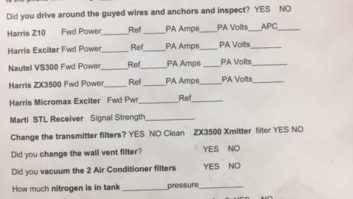
In January, the FCC released what appears to be the final Report and Order on the Emergency Alert System. The Report and Order does not contain any further requests for comments, suggesting that we have reached the final regulatory step in the years-long undertaking to revise and create a modern EAS. I don’t have nearly the room here to give a comprehensive analysis of all the changes the new rules encompass, but I’ll try to go over some of the highlights.
For those who have been keeping close track, there are a few eye-openers.
For me, the elimination of the “Governor Must-Carry” messages was notable. The proposed rule would have bolstered the strength of state emergency networks by forcing stations to carry alerts issued by an appropriate state-level authority.
The only problem was a constitutional one: There was no federal agency (certainly not the FCC) with the authority to require states to provide such alerting. As you can imagine, this is a touchy subject in some parts of the United States, where “states’ rights” is a rallying political cry. The FCC seems to have decided that the circle actually was a square all along; states have the right to use the Integrated Public Alert and Warning System (IPAWS) to distribute alerts. Since the FCC is allowed to require stations to carry alerts, the problem would seem to be solved. States can “opt in” as they choose with local alerting.
If you sport a “Non-participating National” designation, it looks like your time is up — the FCC eliminated that little-used station designation. The previous rules allowed NN stations to leave the air during an actual Emergency Action Notification.
The concept used to be that all participating stations would interrupt their local programming and connect to their local PEP so that live and direct communications from Washington could be broadcast to the country in a largely synchronous relay. That seems quaint by today’s standards (though it brings to mind the drama of worldwide live communication as portrayed in the fine movie “The King’s Speech” last year). In these more practical times, an emergency text could be deployed literally in seconds without having to create an actual live connection for the chief executive to address everyone.
In tandem with eliminating the NN status, the FCC eliminated the Emergency Action Termination. This allows EAS devices to receive national emergency messaging in the same format of tests and AMBER alerts. Once the message has been received and forwarded, stations can automatically return to their regular programming once an End of Message (EOM) code has been issued.
One final important deletion: There will be no “text to speech” conversion allowed in CAP. Personally I liked this idea. If a message has to come a long ways, it is cleaner to turn it back from text to speech locally. But we’ve all heard what happens when it fails, as well as the inherent problems TTS has with place names. Save this one until next round and hope that technology improves.
A LONG ROAD TO THE FIRST STEP
This round of modernization of EAS has taken years. Overall, I have to applaud the efforts of everyone involved. As far as I can tell, all parties have been guided by the best of intentions. Let’s give kudos to the manufacturing community that worked closely with broadcasters to develop the ECIG, the EAS-CAP Industry Group and its best practices document. Broadcasters’ guiding agency, the FCC, had to coordinate with other federal agencies, each with its own agenda and timetable. Many other agencies and administrators had to finalize their decisions before the FCC could even get to the point of proposing new rules. In the end, a truly radical change of the EAS system was not yet possible, even though I would wish that we could have done more.

iStockphoto/DSGpro
To my mind, the crucial step has been made to create what is essentially a parallel distribution system for emergency alerting. The Common Alert Protocol, CAP, offers the essential ability to distribute messages via the public or private Internet. But enough doubts remained about the reliability of the public Internet that the main components of the daisy chain method of national emergency messaging were retained.
We will still have Primary Entry Points (in fact more of them) and state plans that move alerts from one station to another, even though the technology to target local alerts directly has been around for quite some time. Many forward-looking states already use these more modern techniques, but the federal government could not at the last analysis force all states to modernize just yet.
The positive side is that with CAP in place late this spring, it will be possible to begin to answer reliability questions that right now are somewhat speculative. With the National EAN test under our belts, it will now be possible to compare the reliability of CAP distribution to legacy methods using a closed-circuit test. Does anyone really think the results will be worse than what happened in November? And if it works the way it should, the road toward eliminating bottlenecked state plans has a clear path — use IPAWS.
To my mind, the goal is to get to a more reliable, yet mostly silent EAS. If IP distribution works and can be successfully demonstrated then the concept of moving tests off the air and into computers has been shown to be viable. CAP should help to get us there.
IS ANYONE STILL LISTENING?
An interesting point was raised recently by Andrew Stringer on the AWARE website, which focuses on public safety. See www.awareforum.org/2012/01/recap-of-2012-ces-is-broadcast-dead/ for the full entry.
Stringer raised the question of whether all this work on EAS was only a partial solution to a problem that was transforming rapidly.
While the design and implementation of the new EAS has been plodding its way to completion, the media landscape has been changing rapidly. It’s hard to recall, but when the process to modernize EAS was begun (the First Report and Order dates to November 2005), there was no such thing as a smartphone, and wireless networks in the United States were just deploying 3G systems so that consumers could receive wireless data at rates better than a dial-up modem.
Today, 4G rapidly is gaining ground and delivering data rates to mobile devices that outstrip what was known as “high-speed Internet” just a few years ago. Consumers are presented with any number of available gadgets that provide entertainment and information anywhere and everywhere they go, not just at home or in the automobile.
Naturally, this raises questions of relevance:Have we modernized EAS at great effort and expense, only to find that consumers can no longer be reached this way?
Studies have shown that a large portion of audio streaming is of radio station signals themselves. Did we forget to include rules that require insertion to internet streams (a relatively minor change)? What about Internet streams not originating from radio broadcasters?The FCC certainly has no authority over them (nor does anyone at this point in time, for that matter).
Stringer’s point was that emergency management leaders have to start thinking about these new entertainment mediums and how to make them part of emergency messaging.
One idea that was under consideration just a couple of years ago was to try to have all cellphones and portable devices contain an FM tuner. It is a fairly simple step from there to have it activate upon receiving an EAS alert. Clearly this is a powerful solution to alerting on music/program storage devices like iPods. However, the idea caused much upset at the Consumer Electronics Association.
Wireless companies have proposed and are just in the early stages of testing a geographically sensitive “robo texting” as part of the Commercial Mobile Alert System (CMAS), their version of EAS. We’ll see if it can actually handle the potential traffic of an EAN and its associated 100 million or so text messages simultaneously reaching cellphones. At least it’s comforting to know that other communications entities have had to travel a similar path and regulatory burden.
Comment on this or any story in RW Engineering Extra. Email [email protected].








